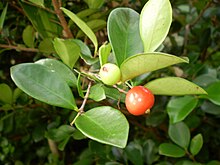Eugenia reinwardtiana is a shrub to small tree in the family Myrtaceae. Native to tropical forests in northern Queensland, Indonesia,[2] and the Pacific Islands, its common names include Cedar Bay Cherry, Beach Cherry, Australian Beach, Mountain Stopper,[3][4] Nīoi (Hawaiian),[5] and A'abang (Chamorro). They are typically 2 to 6 m (6.6 to 19.7 ft) in height.[6]
| Eugenia reinwardtiana | |
|---|---|

| |
| Scientific classification | |
| Kingdom: | Plantae |
| Clade: | Tracheophytes |
| Clade: | Angiosperms |
| Clade: | Eudicots |
| Clade: | Rosids |
| Order: | Myrtales |
| Family: | Myrtaceae |
| Genus: | Eugenia |
| Species: | E. reinwardtiana
|
| Binomial name | |
| Eugenia reinwardtiana | |
| Synonyms[1] | |
|
List
| |
The tree is particularly common around the Cedar Bay National Park in northern Australia and the edible fruit was especially popular with the hippies who lived there in the 1970s.[citation needed]
The fruits are green at first, then ripen to a bright orange-red colour with a sweet taste and soft flesh.[3]
Uses edit
The tree is cultivated to a limited extent for its edible sweetish fruit that is often eaten out-of-hand, used to flavour drinks and candies, or as a preserve. The fruit is a source of antioxidants.[7]
The tree is well-suited to amenity horticulture in the tropics, and is grown in the median strips in Cairns. It is readily propagated from fresh seed.[6]
This species is susceptible to Myrtle Rust (Puccinia psidii).[3]
References edit
- ^ "The Plant List: A Working List of All Plant Species". Retrieved February 5, 2014.
- ^ "Eugenia reinwardtiana". Germplasm Resources Information Network. Agricultural Research Service, United States Department of Agriculture. Retrieved 2009-11-10.
- ^ a b c "Cedar Bay Cherry - Eugenia reinwardtiana". www.daleysfruit.com.au. Retrieved 2020-01-10.
- ^ "Eugenia reinwardtiana (Blume) DC". PLANTS Database. United States Department of Agriculture. Retrieved 2009-11-10.
- ^ "nioi". Hawaiian Ethnobotany Online Database. Bernice P. Bishop Museum. Archived from the original on 2008-03-28. Retrieved 2009-11-10.
- ^ a b Wrigley, J.W., Fagg, M., Australian Native Plants, Collins, 1986, ISBN 0-00-216575-9
- ^ Sullivan, Rachel (30 April 2009). "Rainforest Fruit Power". Australian Broadcasting Corporation.
External links edit
Media related to Eugenia reinwardtiana at Wikimedia Commons Data related to Eugenia reinwardtiana at Wikispecies